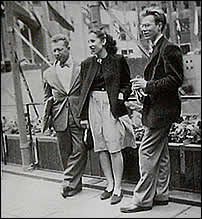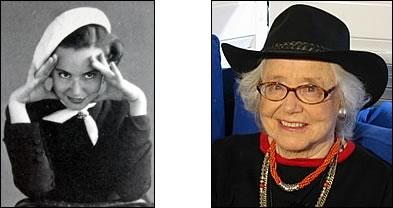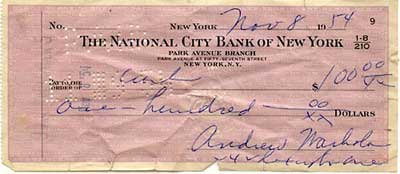Andy Warhol Pre-Pop
by Gary Comenas (2006)
page one
Andy Warhol moved to New York a week after graduating from Carnegie Tech in June 1949 (SC14), armed with a Bachelor's degree in Pictorial Design from the Carnegie Institute of Technology. (AT23) Accompanying him was fellow classmate and future Realist painter, Philip Pearlstein.

Philip Pearlstein (L) and Andy Warhol
(Photographer unknown)
Philip Pearlstein:
I first met Andy when I returned from the army. I went back to Carnegie Tech after getting discharged. I had won a prize in National Scholastic High School [magazine] and a painting was reproduced in Life magazine. So I came back with a kind of notoriety and maybe that's what attracted Andy to me. But he began hanging around. Andy was going through college on an insurance policy that his father left... A big influence in Andy's life at that time was getting a job in a department store, Joseph Horne's. He looked at all the magazines they had and he studied them and I think that was the real influence - not what he was getting in school. After he graduated a friend of ours talked me into coming to New York. I talked Andy into coming to New York 'cause there was absolutely nothing in Pittsburgh at that time for anybody with any kind of ambition.(1)
According to Pearlstein, “We [Pearlstein and Warhol] made a couple of trips together, by train and bus, carrying our stuff in shopping bags. We were broke.”(2) Prior to moving to New York, they had made several exploratory trips to the city. During at least one of these trips, in the summer of 1947, they stayed with George Klauber, a fellow student from Carnegie Tech. Klauber had moved to the city earlier and had found employment as an assistant to Will Burtin who, in 1945, had become the art director of Fortune magazine. By 1949 Burtin had formed his own company and an exhibition of his work had taken place at the A - D Gallery at 130 West 46th Street from November 9, 1948 to January 14, 1949.(3)
THE DRAFT
The college education of both Klauber and Pearlstein had been interrupted by military service whereas Warhol somehow managed to avoid the draft. There are two selective service cards for Warhol in the collection of the Andy Warhol Museum. The first dates from his Pittsburgh youth and rates him "1-a" making him eligible for military service. On the second one, dated in the early 1950s, he is rated as "4-f," rendering him ineligible for service, although no reason is given for the change.(4)
GEORGE KLAUBER
Klauber had studied at the Pratt Institute in Brooklyn before being drafted, but when he re-applied after his military term ended, his application was rejected and he ended up at Carnegie Tech. He studied at Carnegie Tech for one year only - his sophomore year - before successfully returning to Pratt and finishing his education. When Warhol and Pearlstein decided to follow Klauber to New York, he provided them with a list of people to contact for possible commercial illustration work. Whereas Warhol managed to get a commission within days of arriving in Manhattan, Pearlstein wasn't so successful.
Philip Pearlstein:
"[Warhol] was an immediate success. We had a friend [George Klauber] who worked as assistant to an art director and he had access to all the New York directors' numbers. We used those numbers. At the end of the first week Andy had major illustration work from Seventeen magazine. I had no ambitions to be an illustrator - well, I tried and it didn't work - I wanted to be an art director. I became an assistant to Ladislav Sutnar, a graphic designer. He was highly influential, and I met all sorts of people - Josef Albers used to drop by to visit... By the end of my first year in New York I got married. I went back to school and studied art history while working part-time for Sutnar."(5)
The early assignment for Seventeen magazine mentioned by Pearlstein was for an article on allergies commissioned by Joan Fenton, the art director of the magazine. Fenton thought that Warhol's "scratchy" line work was perfect for an article on allergies.(6)
Another early assignment that Warhol received was for the September 1949 issue of Glamour magazine, published by Conde Nast. Tina S. Fredericks, who at the time was the youngest art director in the history of Conde Nast, commissioned Warhol to illustrate a group of articles focusing on success, with titles such as "Success is a Flying Start," "Success is a Career at Home," "Success is a Family Affair," and "Success is a Working Marriage."
According to Warhol, it was on one of his (and Pearlstein's) earlier exploratory trips to New York that he first had contact with Fredericks.
Andy Warhol:
"I went to Carnegie Tech. Phillip Pearlstein was going to New York during a semester break, so I took a shopping bag and we took a bus. We took our portfolios and showed them around New York to see if we could get jobs. The lady from Glamour, Tina Fredericks, said that when I got out of school she'd give me a job. So I got out and came back. That was my first job." (KG235)

Tina S. Fredericks
(Photo: L: Richard Rutledge/R: Unknown)
Tina S. Fredericks:
"I can only surmise what first drew Andy to Glamour. Before it became the fashion magazine for the Girl with a Job, it had achieved renown as the Hollywood movie slick - featuring stars like Ginger Rogers on its covers... Even as a sickly child, Andy worshiped the idols of the silver - his favourite colour - screen. So probably it was no more than the name Glamour that made him call... for glamour was surely what he loved. The day Andy walked in, in the summer of '49, I was five months pregnant with my first child - and properly editorial, in my navy-blue gabardine suit topped by the obligatory chapeau... I greeted a pale, blotchy boy, diffident almost to the point of disappearance but somehow immediately and immensely appealing. He seemed all one colour: pale chinos, pale wispy hair, pale eyes, a strange beige birthmark over the side of his face (almost like a Helen Frankenthaler wash). The big black portfolio he carried was an emphatic accent that would later be replaced by perpetual black leather jackets... The big black portfolio didn't have much in it: some nude figure studies, some flowers, and a charming abstraction of an orchestra playing... His ink lines were electrifying. Fragmented, broken, and intriguing, they grabbed at you with their spontaneous intensity..."(7)
THE BLOTTED LINE
The "fragmented" line that Fredericks refers to would become one of Warhol's trademarks as a commercial illustrator. Vito Giallo, who was hired as Warhol's first commercial art assistant in 1953,(8) later described how Warhol achieved the blotted line effect.
Vito Giallo:
"I was working in an advertising agency where they used his [Warhol's] work and everybody in the studio, and it was a very good studio, couldn't figure out how he did the blotted line... So not until I worked for him did I discover [how he did it] - and it was extremely simple - he just took a piece of Strathmore paper and folded it in half and on the left he would do the pencil drawing and then take pen and ink - india ink - and then slowly go over the line and blot it over and then go back and forth to get a perfect register. And so, in the end, we would have the copy more or less and then the original we would tear off and throw away."(9)
Giallo thought that Warhol later used the technique to do large canvases of Carlton Willers who Warhol met in approximately 1953. Willers was a librarian in the picture library of the New York Public Library in Manhattan where Warhol would peruse the collection for ideas. The canvases no longer exist. When later asked about them, Warhol thought that he "threw them away."(10)
Warhol had started using his blotted line technique in college in order to make his work look "printed." When asked in 1978 how he got the idea, he responded, "Well, it was just that I didn't like the way I drew. I guess we had to do an ink blot or something, and then I realized you can do an ink blot and do that kind of look, and then it would look printed somehow."(17)Jack Wilson, one of Warhol's college classmates later recalled that "blotter paper" was experimented with in the technical resources course at the college.(17b) According to another classmate, Bennard B. Perlman, Warhol discovered the technique accidentally at the student's "hangout" - the University Grill - when Warhol had made a sketch in ink and then blotted it with a paper napkin.(18)During their childhood, Warhol's older brother, Paul, also remembered showing Andy how to cover the surface of a comic with wax, then turn it over on top of a piece of paper and rub the back of it in order to transfer the image. The result was a mirror image of the comic.(19)
Possibly the earliest example of Warhol's blotted line was an illustration he did for the front cover of the November 1948 Carnegie Tech student magazine, Cano. He also used the technique on a Christmas card he sent to George Klauber the same year, although the illustration for Cano pre-dates the card. Warhol's Cano cover was similar to a painting that he had in the portfolio he showed to Tina S. Fredericks. She was so taken with the work - Orchestra - that she purchased it for ten dollars. Fredericks was pregnant at the time and thought it would be perfect for her baby's nursery.
ANDREW WARHOLA BECOMES ANDY WARHOL
Tina Fredericks noticed that Warhol had signed Orchestra as "André Warhola" and inquired about the nationality of the name. Fredericks, herself, was an immigrant who had been born in Berlin but sent to live in London when Hitler came to power and eventually ended up in the display department of Macy's before landing a job with Glamour. Warhol told her that his surname was Czech but that he was going to drop the "a" to make his name simpler. Although Warhol had been born and raised in Pittsburgh, his parents had come from a small village in Eastern Slovakia. When the articles for Glamour were published, he was credited as "Andy Warhol." Yet he was apparently still signing cheques "Andrew Warhola" in 1954.

When asked in interviews why he had dropped the "a" from his last name, Warhol would often indicate that the "a" actually fell out of the portfolio he carried around with him as he visited art directors looking for work. During a 1978 interview he said, "Well, the reason why I dropped the 'a' is that 'cause when I was going around with a portfolio, it just happened by itself." In the same interview he also indicates that "there were other Warhols in the telephone book."(20) One Warhol biographer, David Bourdon, noted that there were "numerous but unconfirmed rumours" that during his early years in New York, Warhol "eluded an enormous phone bill."(21) However, Warhol saved his phone and electric bills from his early days in New York and Patrick S. Smith, who wrote two books on the artist, was unable to find any large phone bills from the early 1950s in the Warhol archives.(21b )Warhol had experimented with a shortened version of his surname as early as 1942 when he had signed a portrait of a friend, Nick Kish, with "A. Warhol."(22) In 1948 he signed a self-portrait he gave to fellow classmate Leonard Kessler as "Andy Warhol."(23) When, as a student, he submitted paintings to the Annual Exhibition of the Associated Artists in 1948 and 1949 he signed his work "Andrew Warhol."(24)
MONTAUK
Although Fredericks left Glamour magazine in the early 1950s, she kept in touch with Warhol. During the late 1950s she would introduce him to Emile De Antonio who Warhol would later credit with inspiring him to become a fine artist and filmmaker. The last job that Fredericks gave Warhol was in 1961 when she commissioned him to draw picnic items for a publication titled Living for Young Homemakers. She gave up publishing work in the early 1960s and started her own real estate company in the Hamptons. In 1972 she would sell a compound of buildings in Montauk to Warhol as a holiday home and in 2002, when Paul Morrissey, who co-owned the property, put the Montauk compound up for sale for $50 million, he enlisted Frederick's expertise.

Warhol's Montauk Compound
(Photographer Unknown)
ST. MARKS AND AVENUE A
Warhol's holiday compound in Montauk was a far cry from his first apartment in New York. When they arrived in New York in 1949, Warhol and Pearlstein initially subleased a cockroach infested apartment at St. Marks and Avenue A in the East Village. The sublease was arranged by the painter Balcomb Greene who had presented a course one term a year at Carnegie Tech called "Humanities, Arts and Civilization." Greene had also helped local Pittsburgh resident, Betty Rockwell Raphael open the Outlines gallery which held a cultural evening on Sunday nights with guest lecturers. According to Pearlstein, they saw "a lot of experimental films" at the gallery including films by Maya Deren.(25) One of the guest lecturers at the gallery was the Dada influenced musician, John Cage.